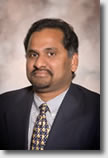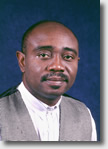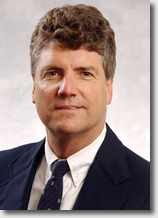Some documents are made available in PDF format. You will need Adobe Reader to view them. 
[ PDF for viewing, 982K
![]() ]
]
[ PDF for printing, 3.8M
![]() ]
]
- Director’s Message
- Inaugural UTCM Fellows Named
- Spotlight on Technology Transfer: New Website Explores Transportation Funding Options
- Spotlight on Research: Improved Demand-Response Productivity and Service Quality through Dispatch Strategies
- What I Did On My Summer Vacation: STI Scholars Program Adds a Second Year STI Experience
- Texas A&M Awards the First Graduate Transportation Planning Certificate
- Mobility Colloquium Continues
Director's Message

Melissa S. Tooley,
Director, UTCM
Midpoint Musings
It is hard to believe that UTCM is halfway through its SAFETEA-LU grant! The past two years have flown by, and significant progress has been made toward accomplishing UTCM’s objectives. One of the charges I was given when entrusted with the UTCM grant was to create programs and/or areas of expertise that would last beyond the grant. With that in mind, it seems appropriate to review some of our activities at the midpoint of the grant.
- The first students have received their Certificate in Transportation Planning from the College of Architecture. Under the leadership of Executive Committee member Forster Ndubisi and supported by UTCM, this new interdisciplinary certificate program is showing great promise here on the Texas A&M campus.
- UTCM is supporting the expansion of the STI program at Prairie View A&M University under the leadership of Dr. Raghava Kammalapati. In addition to enhancing the existing program, a new STI Scholars program has been developed and implemented for second-year STI participants. Dr. K, as he is fondly known to the STI students, was systematic and thorough in the foundation he laid for this program. As a result, we are confident the STI Scholars opportunity will continue to grow after its successful launch this summer.
- UTCM launched a Transportation Funding Options website (http://utcm.tamu.edu/tfo), developed by TTI researcher Tina Geiselbrecht. Currently, the website includes only highway funding alternatives, but funding options for transit projects will be added this year after the completion of a transit funding study by TTI researcher Linda Cherrington. This website is intended to be an unbiased information source on a variety of funding mechanisms for transportation infrastructure improvements.
- We have awarded the first UTCM fellowships to outstanding graduate students.
- We have enhanced the well-known Urban Mobility Report, enabling TTI researcher Tim Lomax and his team to provide for the economic impacts of congestion on freight haulers and how transit impacts congestion.
These are just a few of UTCM’s accomplishments thus far. The future looks bright for UTCM, and our research, education and technology transfer activities are making long-lasting impacts on the state of Texas and beyond.
Optimistically Yours,
Melissa S. Tooley
[ Top ]
Inaugural UTCM Fellows Named
Direct support of students is part of UTCM’s education directive. Students in transportation-related programs may be supported by various means including fellowships, scholarships, stand-alone assistantships, and tuition and/or fee awards.
UTCM worked closely this year with the Zachry Department of Civil Engineering at Texas A&M University to assist in the recruiting of outstanding graduate students. As a result, two promising incoming PhD students, Mr. Ben Sperry and Ms. Susan Paulus, have been named 2008 UTCM Fellows. Each Fellowship carries a two year stipend that supplements the student’s departmental assistantship.

Ben Sperry, UTCM Fellow
Ben Sperry
A native of Springfield, Illinois, Ben Sperry is pursuing a PhD in Civil Engineering at Texas A&M University. In addition to a multi-year UTCM fellowship, he holds an assistantship in the Multimodal Freight Transportation Programs of the Texas Transportation Institute. Ben earned a Master of Science in Civil Engineering from Texas A&M University and a B.S. in Civil Engineering and Engineering Management from the University of Evansville, Indiana. His past work experience includes participation in the Southwest University Transportation Center (SWUTC) Undergraduate Transportation Scholars Program and an internship position with the Evansville Metropolitan Planning Organization. Ben’s research interests include multimodal freight and passenger transport, the link between travel behavior and the built environment and transportation economics.

Susan Paulus, UTCM Fellow
Susan Paulus
Susan C. Paulus graduated from the University of Wisconsin in May with dual degrees: Bachelor of Science in Civil Engineering and Bachelor of Business Administration in Productions and Operations Management. Next month, Suzie will enter Texas A&M as a UTCM Fellow to pursue a PhD in Engineering. When she began her course work, her goal was to start her own engineering firm. But attending the TRB annual meeting this year opened her eyes to her love of research which she shared with TRB participants and her professors. Now her goals after graduate school include becoming a professor and researcher. With only eight percent of engineering faculty being female, Suzie hopes to be a role model for women in engineering and she looks forward to encouraging women to pursue degrees in technical disciplines.
The UTCM is pleased to enhance the development of the transportation and mobility workforce through the training and support of outstanding students. Inaugural UTCM Fellows Ben and Suzie have set the standard for excellence in our student support programs.
This education initiative involves the collaborative efforts of:

[ Top ]
SPOTLIGHT ON TECHNOLOGY TRANSFER
New Website Explores Transportation Funding Options

Project Title: A Guide to Transportation Funding Options
Principal Investigator: Tina Geiselbrecht, Assoc. Transportation Researcher, TTI Austin

UTCM Researcher
Tina Geiselbrecht
As our nation’s transportation demand continues to grow due to population increases and an expanded economy, elected officials at all levels of government are faced with difficult decisions regarding mechanisms to adequately fund the maintenance and expansion of the nation’s transportation systems.
Where does a policy maker go for the concise information and data they need on the options for funding transportation infrastructure improvements?
Thanks to Tina Geiselbrecht, such a resource now exists on the world wide web. With funding from the UTCM and assistance from website developer Tobey Lindsey at Texas Transportation Institute and Martha Raney Taylor at the UTCM, Geiselbrecht has produced a concise, user-friendly website called a Guide to Transportation Funding Options, or TFO, for leaders and policy makers. TFO describes the array of transportation funding options that are or may be available for use throughout the country.
"The TFO site describes each funding option and, where possible, offers links to projects that are utilizing a particular type of funding," says Geiselbrecht. Located within the UTCM website, the TFO website is accessible on the UTCM home page, http://utcm.tamu.edu.
"Phase 1 of the project includes funding for highways, and subsequent phases will focus on additional modes of surface transportation," says Geiselbrecht. "And as we continue to develop the TFO site, we encourage feedback and contributions of material and links by other transportation funding experts."
It is expected that another UTCM project under the direction of Linda Cherrington, Program Manager of the Transit Mobility Program in TTI’s Houston Office, will provide significant information in the fall for mass transit funding options.
For more information, visit the TFO website at
http://utcm.tamu.edu/tfo
[ Top ]
SPOTLIGHT ON RESEARCH
Improved Demand-Response Productivity and Service Quality through Dispatch Strategies
Principal Investigator: Suzie Edrington, Research Specialist, Transit Mobility Program, TTI Houston

UTCM Researcher
Suzie Edrington
Increasingly, seniors are choosing to retire to rural areas. Aging citizens often have fixed incomes and physical or cognitive disabilities impairing their ability to drive. Public transit for these individuals provides access to medical services and grocery stores and allows them to stay involved in the community.
Transit agencies that serve low density, rural service areas or people with disabilities provide demand-response service. Passengers schedule services in advance using a reservation system to arrange pick-up and drop-off at their origin and destination.
While serving the needs of low density areas and disabled citizens, demand-response service costs are at least five times higher per passenger trip than a fixed-route service.
With increasing demand, higher fuel and insurance costs and tighter budgets, transit agencies are searching for ways to control costs while improving productivity.
Transit agencies using demand-response historically invest in advanced scheduling systems, putting less emphasis on the dispatch function that controls actual service delivery. Yet as much as 40% of scheduled service is changed on the day of service due to user cancellations or no-shows and service interruptions by providers. Effective dispatch is therefore key to managing frequent day-of-service changes, increasing productivity and reducing cost.

Capitol Metro (Austin, TX) dispatcher managing an ADA demand response system
"Providers need guidance in improving their dispatch services," says Suzie Edrington, Research Specialist in the Transit Mobility Program of Texas Transportation Institute’s Houston office. With funding from the UTCM, Edrington and her team are conducting research to produce a guidebook to help transit providers emphasize effective dispatch services.
"We have just completed the first phase of the research," reports Edrington. "We began by surveying 42 transit agencies providing demand response services in rural or small urban areas across Texas. We looked at things like annual number of trips, level of the dispatchers’ technology, population density of the district and size of the fleet. Using this data, we selected five Texas transit providers that represent a cross-section of the technologies used and the service levels provided. Now we will conduct a case study of their dispatch operations."

Graduate assistant Angie Lehnert collected data from 42 transit agencies across Texas that provide demand response services.
Edrington and her team, including Jeff Arndt, Research Scientist, in TTI-Houston’s Transit Mobility Program and Texas A&M Masters of Urban Planning student Angie Lehnert (pictured at left), will use results from the case studies to design keys to making demand-response dispatch successful: setting dispatch goals and objectives, staffing according to those goals and objectives, developing policies and procedures for effective operations, communicating "team" responsibilities, and designing and tracking performance measures. The guidebook will outline ways to implement these keys.
Just how much difference can effective management of demand-response transit services make? "With just three percent improvement in service productivity, the average rural demand-response system would save about $65,000 a year," says Edrington.
The guidebook, entitled "Dispatching Demand-Response – Guidebook to Increasing Productivity and Saving Money" will be offered to public transportation coordinators and operators starting January 2009.
This research project involves the collaborative efforts of:

[ Top ]
What I Did On My Summer Vacation
STI Scholars Program Adds a Second Year Experience to Summer Transportation Institute
Project Title: "Partnering to Promote Workforce Development for the Transportation Profession"
Principal Investigator: Raghava Kommalapati, PhD, PE, Associate Professor, Department of Civil and Environmental Engineering, Prairie View A&M University

UTCM Researcher
Raghava Kommalapati
The STI Scholars program, developed by a team headed by UTCM researcher Dr. Raghava Kommalapati of Prairie View A&M’s Department of Civil and Environmental Engineering, provides a second-year experience to returning STI high school students, further cementing their interest in a career in transportation.
STI Scholars La Sasha Walker of Humble, TX and Adam Earls of Cypress, TX were teamed with two Prairie View A&M undergraduate mentors, while they also served as mentors to first-year STI students. During their two week program, they participated in higher level testing, observation and presentations including actual research on RFID technology under the direction of Dr. Erick Jones of Univeristy of Nebraska-Lincoln.

STI Scholars Adam Earls and La Sasha Walker conduct tests on an RFID scanner.
STUDENT PROJECT REPORT
by STI Scholars La Sasha Walker and Adam Earls
The Summer Transportation Institute (STI) goal is to expose high school students to college life and engineering and transportation as a major field of study. In this advanced project, as second year STI students, we became involved in engineering research projects using an emerging technology, Radio Frequency Identification (RFID).
Under the careful guidance Dr. Erick Jones, a world renowned researcher in RFID technologies at the University of Nebraska-Lincoln, we were exposed to the RFID technology through faculty presentation, lectures, videos and experimentation. In addition, Prairie View A&M undergraduate students Quinton Rodgers and Nadine Ford provided day-to-day knowledge and guidance about college life and classroom experiences.
The design methodology implemented was designed by Dr. Jones’ RFID lab.
In this study our goal was to identify the greatest distance at which the programmable RFID tags can read and play music.
This research project involves the collaborative efforts of:

[ Top ]
Texas A&M Awards the First Transportation Certificate
Project Title: Graduate Certificate in Transportation Planning
Principal Investigator: Forster Ndubisi, PhD, ASLA, Professor and Head, Landscape Architecture and Urban Planning, Texas A&M University

UTCM Researcher
Forster Ndubisi
This past Spring, Mr. Rob Rae received a unique Masters in Urban Planning degree from Texas A&M University: his diploma was accompanied by the first ever Transportation Planning Certificate.
The Transportation Certification Program was developed under the direction of Dr. Forster Ndubisi, Professor and Head of Landscape Architecture and Urban Planning in the College of Architecture at Texas A&M with funding provided by the UTCM. The certification in transportation provided Rob an additional focus area of course work in transportation during his two-year M.U.P. program.

Rob Rae, recipient of the first graduate certificate in Transportation Planning
In the certificate program, Rob completed 18 credit hours in transportation-related courses that were comprised of M.U.P. students and graduate students in various engineering disciplines. His instructors included Dr. Eric Dumbaugh, co-PI on the transportation certification project and Assistant Professor of Landscape Architecture and Urban Planning, Drs. Tim Lomax and Bill Eisele, Research Engineers in the Mobility Analysis Program at Texas Transportation Institute, Dr. Dennis Perkinson, Transportation Modeling Program Manager at TTI, and Dr. Luca Quadrifoglio, Assistant Professor in the Zachry Department of Civil Engineering.
"I am grateful for my experience at Texas A&M and I find great value in the certificate that I received," says Rob. "Upon graduation I accepted a great job in Dallas with Kimley-Horn and Associates in their transportation planning group. The knowledge I gained from the courses required for the transportation certificate have greatly benefited me as I transitioned from education to employment."
"The certification is an option for any student at Texas A&M who would like a transportation focus in their graduate training," reports Dr. Ndubisi. "It has application to a wide variety of disciplines, including public health, public policy, parks and recreation, architecture and engineering. By offering this certificate, many more students can expand their career options to include transportation applications."
Six more students are slated to graduate with the Transportation Certificate in Fall 2008 and at least six will follow in Spring 2009. The program has also been formally approved by Texas A&M University, so these graduates will receive not only a separate certificate, but a notation of the certification on their A&M diplomas.
This education project involves the collaborative efforts of:

[ Top ]
Mobility Colloquium Continues
UTCM’s popular and successful colloquium series continued with two additional lunchtime seminars attended by a vareity of Texas A&M and TTI staff and students, both in person and remotely by teleconference.

Dr. Doug Shaw
09.14.2008
"SMILE! You’re on Traffic Light Camera: Applying Stated Choice Modeling to Transportation"
Douglass Shaw, Ph.D.
Professor, Water Resources Policy and Economics, Department of Agricultural Economics, Texas A&M University
A survey technique long used by new product marketers to determine, for example, what type of shampoo consumers might buy, Stated Choice Modeling (SCM) "has a direct application" in transportation projects. Dr. Douglass Shaw had many examples of how SCM might be used by transportation researchers.
Shaw is a professor at Texas A&M University with both the Department of Agricultural Economics and the Department of Recreation, Parks and Tourism Sciences (RPTS).
"Stated Choice Modeling has some advantages in transportation, especially because it gives respondents the chance to choose from several alternatives that don’t yet actually exist," Shaw told the crowd. For example, SCM can help determine what factors might be important in establishing new transportation routes or making improvements in existing ones.
The colloquium title was derived from a project by Agriculture Economics and RPTS graduate students who are using SCM to assess College Station’s existing and future red light camera programs.
In the project, the students are determining how the red light cameras affect driver behavior, as well as road, traffic, and pedestrian safety, at key intersections in Bryan and College Station. Their preliminary results indicate that the assessed fines are an important attribute of the future program. The speed limit at those intersections also matters.
Dr. Tim Lomax and Dr. Mark Burris are both using SCM on their current UTCM projects, including an examination of the potential for congestion lanes on Texas freeways.

Dr. Sue Chrysler
07.14.2008
"Older Road User Safety and Mobility in Australia and Japan"
Sue Chrysler, Ph.D., Senior Research Scientist and Manager, Human Factors Group, Center for Transportation Safety, Texas Transportation Institute
What can the Japanese and Australians teach us about traffic safety for older Americans?

Older road users in Australia
This was the topic of discussion at the latest Mobility Colloquium, presented by Dr. Sue Chrysler, manager of Texas Transportation Institute’s Human Factors Group.
Chrysler’s presentation detailed a recent FHWA International Scan Tour to Japan and Australia, focusing on each country’s efforts to make traveling safer for older drivers, transit users and pedestrians.

Australian educational pamphlet
In examining each country’s safety programs, infrastructure improvements, land use planning and transit operations, Chrysler found that both countries have implemented a wide variety of safety measures with an aging population in mind, including speed control, pedestrian improvements and educating older road users and their families.
"The population of the U.S. is aging," Chrysler says. "And based on our scan tour, it’s clear that the efforts in those countries could lead to initiatives and research opportunities for us."
[ Top ]




